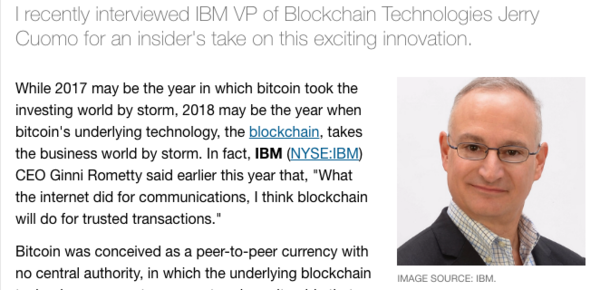While 2017 may be the year in which bitcoin took the investing world by storm, 2018 may be the year when bitcoin's underlying technology, the blockchain, takes the business world by storm. In fact, IBM (NYSE:IBM) CEO Ginni Rometty said earlier this year that, "What the internet did for communications, I think blockchain will do for trusted transactions."
Bitcoin was conceived as a peer-to-peer currency with no central authority, in which the underlying blockchain technology was so transparent and un-alterable that no government entity was needed to govern transactions. That transparency and security is what is so attractive -- and perhaps revolutionary -- to industries such as global finance, shipping, and food safety. Of course, large corporations need a trusted party to run their blockchain networks. With its decades of experience in operating technologies for business, IBM is an early mover in this space.
I was recently afforded the opportunity to hold an exclusive interview with Jerry Cuomo, IBM's vice president of blockchain technologies, to learn more about IBM's active blockchain networks -- some of which are already very large and mature -- as well as the technology behind them. In Part 1 below, we'll go over some of what Cuomo had to say about the high-level picture of what blockchain is and how it is being used already by a variety of industries. In Part 2, I go over what he had to say about how blockchain works in IBM's cloud, how the technology was conceived in the Hyperledger Project, and the current competitive dynamic implementing this open-source technology.
Here are some of the highlights from my conversation with Cuomo. IBM provided the transcript. I edited some of the quotes for clarity.
Blockchain for business
I asked Cuomo to describe from a high-level perspective what blockchain technology is, from IBM's perspective. He said:
I think there are two sides to the coin of blockchain. One is a social phenomenon, but that's powered by a technological phenomenon. And from a social phenomenon, it's really a new way for businesses to interact. Interact in a way that's more direct, and in such a way where trust is distributed across the businesses, to enable the group to achieve more than any of the individual members could achieve.
From that, there's a range of, obviously, more basic cost-saving types of things that a blockchain network could provide to a group of collaborating companies, to a whole new set of business processes. Some that we're conceiving, and some that haven't even been conceived yet. And it's all powered by this distributed ledger technology that is made famous by bitcoin, but not limited to cryptocurrency as a use case.
I then asked him about some of the different blockchains, or "active networks," as the company calls them, and how many of them IBM was currently running.
An active network is something that is a network that has multiple institutions, actively exchanging digital assets of value. So, it's a very simple definition of multiple institutions actively exchanging things of value through a distributed ledger. From that perspective, we're on track this year [2017] to do over 35 of those active networks.
Industry applications
I asked Cuomo and to describe some of the more prominent active networks IBM is managing.
The elder of the group is the Global Finance Network. That's associated with this channel financing network that finances things like parts for computers for institutions assembling or shipping or consuming computer parts. That is about $40 billion per year in capital in that network, and at any given time, there can be up to $100 million in money that is held in dispute. So, you know, I shipped you something. I said I shipped it. You said you haven't received it, but the shipping company said they sent it-- it's not uncommon for that to happen.
A year and a half ago, one of the elder statesmen is this network, where now we have over a dozen of the highest-transacting institutions in this supply chain. There's about 4,000 suppliers and consumers in that network. We only have a small portion of them, but the portion that's responsible for the majority of the interactions. And we're seeing disputes now which were taking on average 44 days now being resolved in under 10 days.
That's the most active of our networks, and part of it is because it's been out for a while. There's several million blocks on the ledger now, representing the transactions that are part of this dispute resolution process.
Source: The Motley Fool (View full article)
Posted by Dan Corcoran on January 8, 2018 11:44 AM



Thank you so much I really loved your writing and I came here after 2 weeks of reading from all different materials and thinking day and night and this is exactly my conclusion.
Check out the site for more info
Thank you very much
Thank you so much I really loved your writing and I came here after 2 weeks of reading from all different materials and thinking day and night and this is exactly my conclusion.
Check out the site for more info
Thank you very much